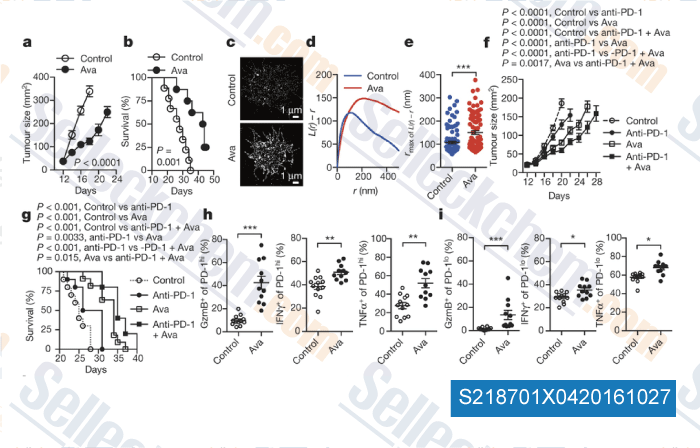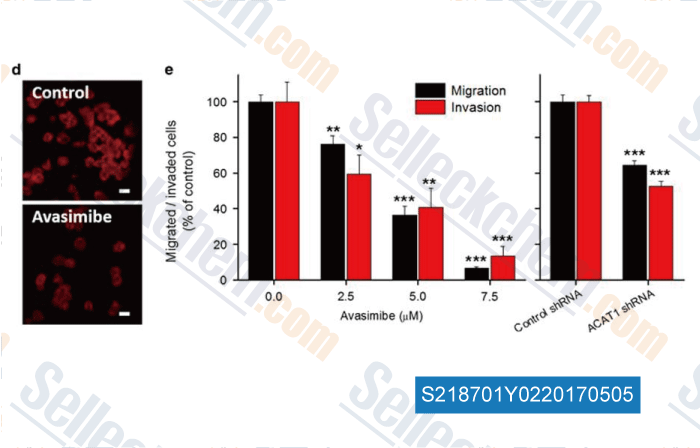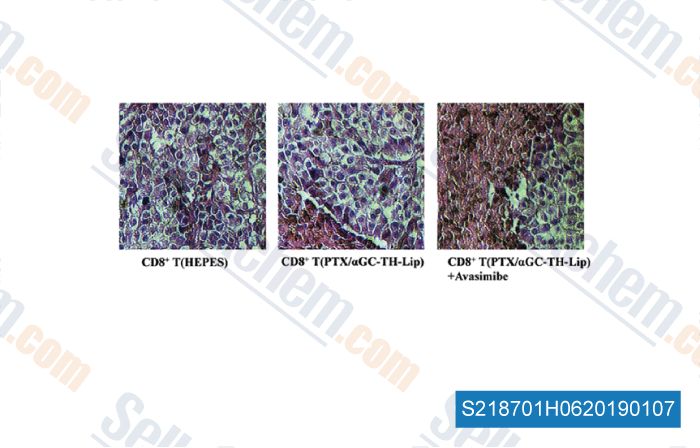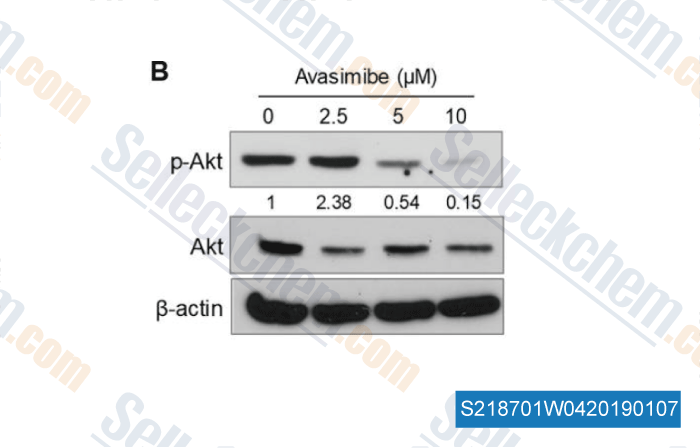|
Toll Free: (877) 796-6397 -- USA and Canada only -- |
Fax: +1-832-582-8590 Orders: +1-832-582-8158 |
Tech Support: +1-832-582-8158 Ext:3 Please provide your Order Number in the email. |
Technical Data
| Formula | C29H43NO4S |
|||
| Molecular Weight | 501.72 | CAS No. | 166518-60-1 | |
| Solubility (25°C)* | In vitro | DMSO | 100 mg/mL (199.31 mM) | |
| Ethanol | 11 mg/mL (21.92 mM) | |||
| Water | Insoluble | |||
|
* <1 mg/ml means slightly soluble or insoluble. * Please note that Selleck tests the solubility of all compounds in-house, and the actual solubility may differ slightly from published values. This is normal and is due to slight batch-to-batch variations. * Room temperature shipping (Stability testing shows this product can be shipped without any cooling measures.) |
||||
Preparing Stock Solutions
Biological Activity
| Description | Avasimibe inhibits ACAT with IC50 of 3.3 μM, also inhibits human P450 isoenzymes CYP2C9, CYP1A2 and CYP2C19 with IC50 of 2.9 μM, 13.9 μM and 26.5 μM, respectively. | ||||||||
|---|---|---|---|---|---|---|---|---|---|
| Targets |
|
||||||||
| In vitro | Avasimibe at concentration of 1μg/mL causes reduction of Total cholesterol (TC) and Esterified cholesterol (EC) through inhibiting LDL binding and decreasing scavenger receptor numbers during foam cell formation in human monocyte-derived macrophages (HMMs). Avasimibe at concentration of 2μg/mL enhances cholesterol efflux from established HMM foam cells preincubating with 10μg/ml LDL. [1] Avasimibe inhibits Lipoprotein(a) accumulation in the culture media of primary monkey hepatocyte in a dose-dependent manner with 11.9% -31.3% inhibition, the change is mainly associated with decreased ApoA. [2] Avasimibe incubating at concentration of 10 nM, 1 μM, and 10 μM for 24 hours in HepG2 cells reduce ApoB secretion into media by 25%, 27%, and 43%, respectively. Avasimibe decreases ApoB secretion by enhanced intracellular degradation of ApoB rather than decreased synthesis of ApoB. [3] Avasimibe inhibits ACTC with IC50 of 3.3 μM in IC-21 macrophages with consideration of the total inhibitor concentration in the assay sample. [4] Avasimibe inhibits human P450 isoenzymes CYP2C9, CYP1A2 and CYP2C19 with IC50 of 2.9 μM, 13.9 μM and 26.5 μM, respectively. [5] Avasimibe inhibits ACAT-1 expression and cholesterol ester synthesis in glioma cell lines. Avasimibe inhibits the growth of the glioma cells by inducing cell cycle arrest and apoptosis due to caspase-8 and caspase-3 activation. [6] |
||||||||
| In vivo | Avasimibe significantly reduces Lipoprotein(a) and total cholesterol levels in nine healthy male monkeys with a normal chow diet orally treated with CI-1011 at 30 mg/kg per day for 3 weeks, Lipoprotein(a) and total cholesterol levels reduce to 68 and 73% of control levels, respectively. Avasimibe decreases total cholesterol mainly due to reduction of low density lipoprotein (LDL). [2] Avasimibe decreases amyloid plaque load in the cortex and hippocampus and reduces the levels of insoluble Abeta40 and Abeta42 and C-terminal fragments of amyloid precursor protein (APP) in brain extracts in young human APP transgenic mice. Avasimibe reduces diffuse amyloid plaques by suppression of astrogliosis and enhanced microglial activation in aged human APP transgenic mice. [7] |
Protocol (from reference)
| Kinase Assay: |
|
|---|---|
| Cell Assay: |
|
| Animal Study: |
|
References
Customer Product Validation

-
, , Nature, 2016, 531(7596):651-5.

-
Data from [Data independently produced by , , Oncogene, 2016, 35(50):6378-6388]

-
Data from [Data independently produced by , , Nanomedicine, 2018, 14(8):2541-2550]

-
Data from [Data independently produced by , , PLoS One, 2018, 13(2):e0193318]
Selleck's Avasimibe has been cited by 23 publications
| Specific activation of the integrated stress response uncovers regulation of central carbon metabolism and lipid droplet biogenesis [ Nat Commun, 2024, 15(1):8301] | PubMed: 39333061 |
| Stimulation of neutral lipid synthesis via viral growth factor signaling and ATP citrate lyase during vaccinia virus infection [ J Virol, 2024, 98(11):e0110324] | PubMed: 39475274 |
| An ACAT inhibitor suppresses SARS-CoV-2 replication and boosts antiviral T cell activity [ PLoS Pathog, 2023, 19(5):e1011323] | PubMed: 37134108 |
| Metabolic interventions improve HBV envelope-specific T-cell responses in patients with chronic hepatitis B [ Hepatol Int, 2023, 10.1007/s12072-023-10490-4] | PubMed: 36976426 |
| Cholesterol mediated ferroptosis suppression reveals essential roles of Coenzyme Q and squalene [ Commun Biol, 2023, 6(1):1108] | PubMed: 37914914 |
| Avasimibe Alleviates Disruption of the Airway Epithelial Barrier by Suppressing the Wnt/β-Catenin Signaling Pathway [ Front Pharmacol, 2022, 13:795934] | PubMed: 35222024 |
| Targeting cholesterol esterification as a novel immune checkpoint in viral infections and cancer [ UCL-, 2022, ] | PubMed: None |
| Targeting human Acyl-CoA:cholesterol acyltransferase as a dual viral and T cell metabolic checkpoint [ Nat Commun, 2021, 12(1):2814] | PubMed: 33990561 |
| Development of potent and selective inhibitors targeting the papain-like protease of SARS-CoV-2 [ Cell Chem Biol, 2021, S2451-9456(21)00213-0] | PubMed: 33979649 |
| Cholesterol activates the Wnt/PCP-YAP signaling in SOAT1-targeted treatment of colon cancer [ Cell Death Discov, 2021, 7(1):38] | PubMed: 33637695 |
RETURN POLICY
Selleck Chemical’s Unconditional Return Policy ensures a smooth online shopping experience for our customers. If you are in any way unsatisfied with your purchase, you may return any item(s) within 7 days of receiving it. In the event of product quality issues, either protocol related or product related problems, you may return any item(s) within 365 days from the original purchase date. Please follow the instructions below when returning products.
SHIPPING AND STORAGE
Selleck products are transported at room temperature. If you receive the product at room temperature, please rest assured, the Selleck Quality Inspection Department has conducted experiments to verify that the normal temperature placement of one month will not affect the biological activity of powder products. After collecting, please store the product according to the requirements described in the datasheet. Most Selleck products are stable under the recommended conditions.
NOT FOR HUMAN, VETERINARY DIAGNOSTIC OR THERAPEUTIC USE.
